
As AI agents in industrial operations become more capable, MCP could well become the fabric that ties everything together.
The embracement of agentic AI in industrial organizations is on the rise. However, as is the case with the adoption of any new technology, obstacles and issues often arise when trying to scale from one-off and pilot projects to enterprise-wide use of the technology. One development that can help is the Model Context Protocol (MCP).
Why? One important aspect that must be addressed when scaling agentic AI is how the different agents can work together. For industrial enterprises with sprawling ecosystems of tools, data sources, and automation systems, this is the critical question that must be addressed for scaling success.
Increasingly, organizations are looking to the Model Context Protocol (MCP) to help.
What is MCP?
MCP is an emerging open standard that some believe will let organizations meld discrete AI agents into a collaborative group of tools that can be used to automate processes and operations across an enterprise. AI could become the connective tissue of large-scale AI deployment. Its role in the agentic AI space is often compared to that of APIs in helping cloud-native applications work together and share resources.
At its core, MCP defines a common language and protocol for connecting AI agents to external systems, data, and workflows. It can serve as a universal interface that allows different agents to plug into corporate systems without custom integrations for each connection. Instead of building one-off connectors for every tool or data source, organizations can use MCP to create a single, standardized bridge that all agents understand.
The protocol itself operates on a simple but powerful model: the MCP client (the agent) can access resources, tools, and prompts provided by an MCP server. The server acts as the gateway to data repositories, APIs, or business systems, while the client consumes and acts on that information. That abstraction has important implications for scalability and interoperability in industrial AI.
See also: MCP: Enabling the Next Phase of Enterprise AI
Providing the Missing Fabric for Multi-Agent Collaboration
Most industrial organizations have invested heavily in automation over the last ten years or longer. That work includes the deployment of manufacturing execution systems, ERP platforms, asset management tools, IoT telemetry, and analytics pipelines. But these systems have traditionally operated in silos.
As companies begin to deploy agentic AI, they usually discover that the power of agents multiplies when they can work together. A maintenance agent might detect a vibration anomaly in a motor. A supply chain agent might reschedule parts delivery in response. A production planning agent could reroute jobs to another line. None of that happens efficiently without a standardized way for agents to exchange information and invoke each other’s capabilities.
MCP allows each agent to expose its services in a consistent way that other agents can discover and call. That capability is crucial because, without such a protocol, every integration becomes bespoke. Each agent would need to understand the idiosyncrasies of every system it touches. That results in a scaling nightmare that quickly turns a promising AI initiative into a maintenance burden.
See also: Enabling a New Wave of Innovations with Agentic AI
Why MCP Changes the Economics of AI Deployment
The benefits of MCP can be grouped into a few big themes.
First, there is interoperability and composability. Once an organization exposes its systems through MCP servers, any compliant agent can access those systems without a single line of new integration code. Agents become modular building blocks that are interchangeable and upgradable.
Second, there is context continuity. Traditional APIs are transactional. They execute a function and return a result. MCP, however, is contextual. It carries semantic metadata that includes information about what the data represents, where it came from, and how it should be used. That continuity allows agents to reason across steps, track provenance, and make decisions that are more grounded in the full operational picture.
Third, there is governance and security. MCP creates a clear boundary between what the agent can do and what the underlying systems allow. Permissions, access scopes, and audit trails can all be defined at the MCP layer, allowing organizations to monitor agent actions just as they would any other automated process. That capability is especially critical in industrial environments, where safety and compliance are non-negotiable.
Finally, there is reuse and scalability. Once an MCP server exposes a function (e.g., a predictive maintenance model or a scheduling API), every other agent in the ecosystem can leverage it. That dramatically reduces duplication and speeds up deployment of new agent capabilities.
See also: Agentic AI in Industry: The Technologies That Will Deliver Results
How Industrial Enterprises Can Put MCP to Work
For an industrial company, adopting MCP doesn’t mean ripping out existing systems. Instead, it means layering a common interface on top of them. The most pragmatic starting point is to identify domains where agentic automation can deliver tangible value. That might include areas like maintenance, logistics, production optimization, or quality assurance.
From there, an organization can stand up MCP servers that expose key tools and data in those domains. For example, a manufacturing execution system might expose “start job,” “update order,” and “get status” tools through MCP. A separate IoT system might provide “read sensor data” or “trigger alert” functions. Once those are in place, AI agents built as MCP clients can use these capabilities seamlessly.
Over time, the organization can expand the network by adding new servers, allowing agents to invoke one another, and orchestrating cross-domain workflows. Eventually, a maintenance agent could detect a problem, invoke a supply chain agent to order parts, and trigger a scheduling agent to replan production. All of that could be accomplished through standard MCP calls.
The Road Ahead
Industrial enterprises that begin exploring MCP now will be better positioned to build flexible, auditable, and extensible AI ecosystems. As AI agents become more capable, MCP could well become the fabric that ties it all together.
In that sense, the adoption of MCP provides a way for industrial organizations to scale discrete agentic AI efforts in specific domains into an enterprise-wide agentic automation strategy.





